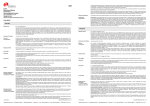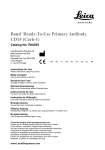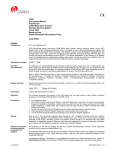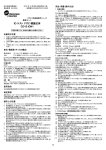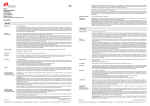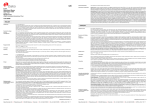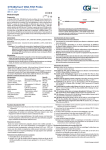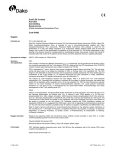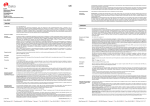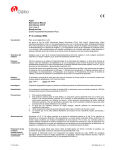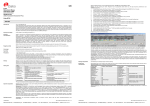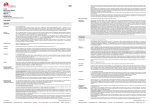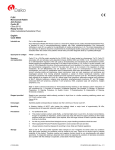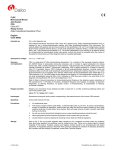Download Monoclonal Mouse
Transcript
FLEX Monoclonal Mouse Anti-Human CD15 Clone Carb-3 Ready-to-Use (Dako Autostainer/Autostainer Plus) Code IS062 English Intended use For in vitro diagnostic use. FLEX Monoclonal Mouse Anti-Human CD15, Clone Carb-3, Ready-to-Use, (Dako Autostainer/Autostainer Plus), is intended for use in immunohistochemistry together with Dako Autostainer/Autostainer Plus instruments. This antibody is useful for the identification of mature granulocytes, mononuclear Hodgkin's cells, and Reed-Sternberg cells in Hodgkin’s lymphoma (1). The clinical interpretation of any staining or its absence should be complemented by morphological studies using proper controls and should be evaluated within the context of the patient's clinical history and other diagnostic tests by a qualified pathologist. Synonyms for antigen Lewis X (Lex) antigen (2,3), 3-fucosyl-N-acetyllactosamine [3-FL] (4), X-hapten (3,5), stage-specific embryonic antigen-1 [SSEA-1] (2,3), lacto-N-fucopentaose III [LNFP III] (3). Summary and explanation CD15 is expressed on Reed-Sternberg cells of Hodgkin’s disease and by various other cell types including myeloid cells and epithelial cells (3-6). Antibodies to CD15 recognize a pentasaccharide sequence occurring in lacto-N-fucopentaose III ceramide (also referred to as X hapten of Lex) found in higher glycolipids and glycoproteins (2,5). Refer to Dako’s General Instructions for Immunohistochemical Staining or the detection system instructions of IHC procedures for: 1) Principle of Procedure, 2) Materials Required, Not Supplied, 3) Storage, 4) Specimen Preparation, 5) Staining Procedure, 6) Quality Control, 7) Troubleshooting, 8) Interpretation of Staining, 9) General Limitations. Reagent provided Ready-to-use monoclonal mouse antibody provided in liquid form in a buffer containing stabilizing protein and 0.015 mol/L NaN3. Clone: Carb-3 Isotype: IgM, kappa Immunogen Affinity-isolated X-hapten oligopeptide fragment from myelomonocytic leukemia cells Specificity In Western blotting of HL60 cell lysates the antibody labels a major band of ~220 kDa corresponding to the expected molecular weight of CD15 (7). Precautions 1. For professional users. 2. This product contains sodium azide (NaN3), a chemical highly toxic in pure form. At product concentrations, though not classified as hazardous, sodium azide may react with lead and copper plumbing to form highly explosive build-ups of metal azides. Upon disposal, flush with large volumes of water to prevent metal azide build-up in plumbing. 3. As with any product derived from biological sources, proper handling procedures should be used. 4. Wear appropriate Personal Protective Equipment to avoid contact with eyes and skin. 5. Unused solution should be disposed of according to local, State and Federal regulations. Storage Store at 2-8 °C. Do not use after expiration date stamped on vial. If reagents are stored under any conditions other than those specified, the conditions must be verified by the user. There are no obvious signs to indicate instability of this product. Therefore, positive and negative controls should be run simultaneously with patient specimens. If unexpected staining is observed which cannot be explained by variations in laboratory procedures and a problem with the antibody is suspected, contact Dako Technical Support. Specimen preparation including materials required but not supplied The antibody can be used for labeling formalin-fixed, paraffin-embedded tissue sections. Tissue specimens should be cut into sections of approximately 4 µm. Pre-treatment with heat-induced epitope retrieval (HIER) is required. Optimal results are obtained by pretreating tissues using EnVision FLEX Target Retrieval Solution, High pH (10x) (Dako Autostainer/Autostainer Plus) (Code K8010/K8014). Deparaffinized sections: Pre-treatment of deparaffinized formalin-fixed, paraffin-embedded tissue sections is recommended using Dako PT Link (Code PT100/PT101). For details, please refer to the PT Link User Guide. (117467-001) 307140EFG_001 p. 1/8 Follow the pre-treatment procedure outlined in the package insert for EnVision FLEX Target Retrieval Solution, High pH (10x) (Dako Autostainer/Autostainer Plus) (Code K8010/K8014). The following parameters should be used for PT Link: Pre-heat temperature: 65 °C; epitope retrieval temperature and time: 97 °C for 20 (±1) minutes; cool down to 65 °C. Rinse sections with diluted room temperature EnVision FLEX Wash Buffer (10x) (Dako Autostainer/Autostainer Plus) (Code K8010). Paraffin-embedded sections: As alternative specimen preparation, both deparaffinization and epitope retrieval can be performed in the PT Link using a modified procedure. See the PT Link User Guide for instructions. After the staining procedure has been completed, the sections must be dehydrated, cleared and mounted using permanent mounting medium. The tissue sections should not dry out during the treatment or during the following immunohistochemical staining procedure. For greater adherence of tissue sections to glass slides, the use of Dako Silanized Slides (Code S3003) is recommended. Staining procedure including materials required but not supplied The recommended visualization system is EnVision FLEX, High pH (Dako Autostainer/Autostainer Plus) (Code K8010). The staining steps and incubation times are pre-programmed into the software of Dako Autostainer/Autostainer Plus instruments, using the following protocols: Template protocol: FLEXRTU2 (200 uL dispense volume) or FLEXRTU3 (300 uL dispense volume) Autoprogram (without counterstaining): CD15 or Autoprogram (with counterstaining): CD15H The Auxiliary step should be set to “rinse buffer” in staining runs with ≤10 slides. For staining runs with >10 slides the Auxiliary step should be set to “none.” This ascertains comparable wash times. All incubation steps should be performed at room temperature. For details, please refer to the Operator’s Manual for the dedicated instrument. If the protocols are not available on the used Dako Autostainer instrument, please contact Dako Technical Services. Optimal conditions may vary depending on specimen and preparation methods, and should be determined by each individual laboratory. If the evaluating pathologist should desire a different staining intensity, a Dako Application Specialist/Technical Service Specialist can be contacted for information on re-programming of the protocol. Verify that the performance of the adjusted protocol is still valid by evaluating that the staining pattern is identical to the staining pattern described in “Performance characteristics.” Counterstaining in hematoxylin is recommended using EnVision FLEX Hematoxylin (Dako Autostainer/Autostainer Plus) (Code K8018). Non-aqueous, permanent mounting medium is recommended. Positive and negative controls should be run simultaneously using the same protocol as the patient specimens. The positive control tissue should include neutrophiles, eosinophiles and germinal center macrophages and the cells/structures should display reaction patterns as described for this tissue in “Performance characteristics” in all positive specimens. The recommended negative control reagent is FLEX Negative Control, Mouse (Dako Autostainer/Autostainer Plus) (Code IS750). Staining interpretation The cellular staining pattern is cytoplasmic and/or membranous (1,5). Performance characteristics Normal tissues: Tissue Type (#tested) Adrenal (3) Bone marrow (3) Breast (2) Brain/cerebellum (3) Brain/cerebrum (3) Cervix (2) Colon (2) Esophagus (2) Heart (3) Kidney (3) Liver (3) Lung (3) Mesothelial cells (3) Nerve (3) Ovary (3) Pancreas (3) Parathyroid (3) (117467-001) Positively Staining Tissue Elements 3/3 Endocrine cells of adrenal cortex (100%), cytoplasmic 2/3 Myelocytes (100%), cytoplasmic 1/3 All cells (100%), cytoplasmic 2/2 Ductal epithelium (25-100%), cytoplasmic 3/3 White matter, grey matter (100%), diffuse 3/3 White matter, grey matter (100%), diffuse 0/2 1/2 Mucosal glandular epithelium (50%), punctuate, apical cytoplasmic 1/2 Mucosal epithelium (20%), apical cytoplasmic 2/2 Non-basal squamous epithelium (100%), cytoplasmic 0/3 3/3 Cortical tubular epithelium (100%), cytoplasmic 2/3 Cortical and medullary endothelium (100%), cytoplasmic 1/3 Sinusoidal endothelium (40%), cytoplasmic 0/3 2/3 Mesothelial cells (100%), cytoplasmic 0/3 0/3 2/3 Acinar cell (25-50%), cytoplasmic 0/3 307140EFG_001 p. 2/8 Pituitary (3) Prostate (2) Salivary gland (3) Skeletal muscle (3) Skin (3) Small intestine (3) Spleen (3) Stomach (3) Testis (3) Thymus (3) Thyroid (2) Tonsil (3) Uterus (2) 3/3 Endocrine cells of adenohypophysis (75-100%), cytoplasmic 2/3 Neuropil of neurohypophysis (75-100%), diffuse 1/2 Glandular epithelium (50%), cytoplasmic 1/3 Ductal epithelium (100%), apical cytoplasmic 1/3 Glandular epithelium (20%), cytoplasmic 0/3 0/3 1/3 Mucosal epithelium (20%), apical cytoplasmic 3/3 Myeloid cells (100%), cytoplasmic 3/3 Gastric mucosa (100%), cytoplasmic 0/3 2/3 Hassel’s corpuscles (100%), non-cellular 0/2 2/3 Overlying squamous epithelium (50-100%), cytoplasmic 2/2 Glandular epithelium (15-75%), cytoplasmic Abnormal tissues: A review by Arber et al. has reported that antibodies to CD15 demonstrate positive staining in 87% of Hodgkin’s disease including nodular sclerosing, mixed cellularity, and lymphocyte depletion, whereas the lymphocyte predominant variant exhibits a lower rate of positivity (37%). Among non-Hodgkin’s lymphoma, 13% express CD15 including 4.1% B-cell, 21% T-cell, and 17% null-cell. CD15 expression has also been demonstrated in acute myeloid leukemia (65%) and chronic myelogenous leukemia (96% chronic phase and 54% blast phase). A relatively low level of CD15 expression has been reported in acute lymphoblastic leukemia (5.7% overall) with positivity observed in 7.7% common or precursor B-cell, 0% B-cell, 7.7% T-cell and 17.3% null-cell. Carcinomas derived from various organs have also been shown to be CD15 positive (56%) including adenocarcinomas, squamous cell carcinomas and undifferentiated large and small cell carcinomas (5). Français Réf. IS062 Utilisation prévue Pour utilisation diagnostique in vitro. FLEX Monoclonal Mouse Anti-Human CD15, clone Carb-3, Ready-to-Use, (Dako Autostainer/Autostainer Plus), est destiné à une utilisation en immunohistochimie avec les instruments Dako Autostainer/Autostainer Plus. Cet anticorps est utile pour l’identification des granulocytes matures, des cellules mononucléaires de Hodgkin, et des cellules de Reed-Sternberg dans les cas de lymphomes hodgkiniens (1). L’interprétation clinique de toute coloration ou son absence doit être complétée par des études morphologiques en utilisant des contrôles appropriés et doit être évaluée en fonction des antécédents cliniques du patient et d’autres tests diagnostiques par un pathologiste qualifié. Synonymes de l’antigène Antigène Lewis X (Lex) (2,3), 3-fucosyl-N-acétyl-lactosamine [3-FAL] (4), haptène X (3,5), antigène embryonnaire spécifique au stade 1 [SSEA-1] (2,3), lacto-N-fucopentaose III [LNFP III] (3). Résumé et explication Le CD15 est exprimé sur les cellules de Reed-Sternberg de la maladie de Hodgkin et par plusieurs autres types de cellules, notamment les cellules myéloïdes et épithéliales (3-6). Les anticorps dirigés contre le CD15 reconnaissent une séquence pentasaccharide qui se produit dans le lacto-N-fucopentaose III céramide (également appelé haptène X de Lex) présent dans les glycolipides et glycoprotéines supérieurs (2,5). Se référer aux Instructions générales de coloration immunohistochimique de Dako ou aux instructions du système de détection relatives aux procédures IHC pour plus d’informations concernant les points suivants : 1) Principe de procédure, 2) Matériels requis mais non fournis, 3) Conservation, 4) Préparation des échantillons, 5) Procédure de coloration, 6) Contrôle qualité, 7) Dépannage, 8) Interprétation de la coloration, 9) Limites générales. Réactifs fournis Anticorps monoclonal de souris prêt à l’emploi fourni sous forme liquide dans un tampon contenant une protéine stabilisante et 0,015 mol/L d’azide de sodium. Clone : Carb-3 Isotype : IgM, kappa Immunogène Fragment d’oligopeptide d’haptène isolé par affinité provenant de cellules leucémiques myélomonocytaires Spécificité Par Western blot de lysats de cellules HL60, l’anticorps marque une bande principale d’environ 220 kDa correspondant au poids moléculaire attendu du CD15 (7). (117467-001) 307140EFG_001 p. 3/8 Précautions 1. Pour utilisateurs professionnels. 2. Ce produit contient de l’azide de sodium (NaN3), produit chimique hautement toxique dans sa forme pure. Aux concentrations du produit, bien que non classé comme dangereux, l’azide de sodium peut réagir avec le cuivre et le plomb des canalisations et former des accumulations d’azides métalliques hautement explosifs. Lors de l’élimination, rincer abondamment à l’eau pour éviter toute accumulation d’azide métallique dans les canalisations. 3. Comme avec tout produit d’origine biologique, des procédures de manipulation appropriées doivent être respectées. 4. Porter un vêtement de protection approprié pour éviter le contact avec les yeux et la peau. 5. Les solutions non utilisées doivent être éliminées conformément aux réglementations locales et nationales. Conservation Conserver entre 2 et 8 °C. Ne pas utiliser après la date de péremption imprimée sur le flacon. Si les réactifs sont conservés dans des conditions autres que celles indiquées, celles-ci doivent être validées par l’utilisateur. Il n’y a aucun signe évident indiquant l’instabilité de ce produit. Par conséquent, des contrôles positifs et négatifs doivent être testés en même temps que les échantillons de patient. Si une coloration inattendue est observée, qui ne peut être expliquée par un changement des procédures du laboratoire, et en cas de suspicion d’un problème lié à l’anticorps, contacter l’assistance technique de Dako. Préparation des échantillons y compris le matériel requis mais non fourni L’anticorps peut être utilisé pour le marquage des coupes de tissus inclus en paraffine et fixés au formol. L'épaisseur des coupes d'échantillons de tissu doit être d’environ 4 µm. Le prétraitement avec un démasquage d’épitope induit par la chaleur (HIER) est nécessaire. Des résultats optimaux sont obtenus en prétraitant les tissus à l’aide de la EnVision FLEX Target Retrieval Solution, High pH (10x), (Dako Autostainer/Autostainer Plus) (Réf. K8010/K8014). Coupes déparaffinées : Le pré-traitement des coupes de tissus déparaffinés fixés au formol et inclus en paraffine est recommandé à l’aide du Dako PT Link (Réf. PT100/PT101). Pour plus de détails, se référer au Guide d’utilisation du PT Link. Suivre la procédure de pré-traitement indiquée dans la notice pour la EnVision FLEX Target Retrieval Solution, High pH (10x), (Dako Autostainer/Autostainer Plus) (Réf. K8010/K8014). Les paramètres suivants doivent être utilisés pour le PT Link : Température de préchauffage : 65 °C; température et durée de restauration de l’épitope : 97 °C pour 20 (±1) minutes ; laisser refroidir jusqu’à 65 °C. Rincer les coupes avec un EnVision FLEX Wash Buffer (10x), dilué à température ambiante (Dako Autostainer/Autostainer Plus) (Réf. K8010). Coupes incluses en paraffine : Comme préparation alternative des échantillons, le déparaffinage et la restauration de l’épitope peuvent être réalisés dans le PT Link à l’aide d’une procédure modifiée. Se référer aux instructions du Guide d’utilisation du PT Link. Une fois que la procédure de coloration est terminée, les coupes doivent être déshydratées, lavées et montées à l’aide d’un milieu de montage permanent. Les coupes de tissus ne doivent pas sécher lors du traitement ou lors de la procédure de coloration immunohistochimique suivante. Pour une meilleure adhérence des coupes de tissus sur les lames de verre, il est recommandé d’utiliser des lames Dako Silanized Slides (Réf. S3003). Procédure de coloration y compris le matériel requis mais non fourni Le système de visualisation recommandé est le EnVision FLEX, High pH, (Dako Autostainer/Autostainer Plus) (Réf. K8010). Les étapes de coloration et d’incubation sont préprogrammées dans le logiciel des instruments Dako Autostainer/Autostainer Plus, à l’aide des protocoles suivants : Protocole modèle : FLEXRTU2 (volume de distribution de 200 µl) ou FLEXRTU3 (volume de distribution de 300 µl) Autoprogram (sans contre-coloration) : CD15 ou Autoprogram (avec contre-coloration) : CD15H L’étape Auxiliary doit être réglée sur « rinse buffer » lors des cycles de coloration avec ≤10 lames. Pour les cycles de coloration de >10 lames, l’étape Auxiliary doit être réglée sur « none ». Cela confirme des temps de lavage comparables. Toutes les étapes d’incubation doivent être effectuées à température ambiante. Pour plus de détails, se référer au Manuel de l’opérateur spécifique à l'instrument. Si les protocoles ne sont pas disponibles sur l’instrument Dako Autostainer utilisé, contacter le service technique de Dako. Les conditions optimales peuvent varier en fonction du prélèvement et des méthodes de préparation, et doivent être déterminées par chaque laboratoire individuellement. Si le pathologiste qui réalise l’évaluation désire une intensité de coloration différente, un spécialiste d’application/spécialiste du service technique de Dako peut être contacté pour obtenir des informations sur la re-programmation du protocole. Vérifier que l'exécution du protocole modifié est toujours valide en vérifiant que le schéma de coloration est identique au schéma de coloration décrit dans les « Caractéristiques de performance ». Il est recommandé d’effectuer une contre-coloration à l’aide d’hématoxyline EnVision FLEX Hematoxylin, (Dako Autostainer/Autostainer Plus) (Réf. K8018). L’utilisation d’un milieu de montage permanent non aqueux est recommandée. (117467-001) 307140EFG_001 p. 4/8 Des contrôles positifs et négatifs doivent être réalisés en même temps et avec le même protocole que les échantillons du patient. Le contrôle de tissu positif doit comprendre des neutrophiles, des éosinophiles et des macrophages des centres germinatifs et les cellules/structures doivent présenter des schémas de réaction tels que décrits pour ces tissus dans les « Caractéristiques de performance » pour tous les échantillons positifs. Le contrôle négatif recommandé est le FLEX Negative Control, Mouse, (Dako Autostainer/Autostainer Plus) (Réf. IS750). Interprétation de la coloration Le schéma de coloration cellulaire est cytoplasmique et/ou membranaire (1,5). Caractéristiques de performance Tissus sains : Type de tissus (nbre testés) Surrénale (3) Moelle osseuse (3) Sein (2) Cerveau, cervelet (3) Cerveau/cervelet (3) Col de l’utérus (2) Côlon (2) Œsophage (2) Cœur (3) Rein (3) Foie (3) Poumon (3) Cellules mésothéliales (3) Nerf périphérique (3) Ovaire (3) Pancréas (3) Parathyroïde (3) Hypophyse (3) Prostate (2) Glande salivaire (3) Muscle squelettique (3) Peau (3) Intestin grêle (3) Rate (3) Estomac (3) Testicule (3) Thymus (3) Thyroïde (2) Amygdale (3) Utérus (2) Éléments de tissus colorés positivement 3/3 des cellules endocrines du cortex surrénal (100 %), cytoplasmiques 2/3 myélocytes (100 %), cytoplasmiques 1/3 de toutes les cellules (100 %), cytoplasmiques 2/2 épithélium canalaire (25-100 %), cytoplasmiques 3/3 matière blanche, matière grise (100 %), diffus 3/3 matière blanche, matière grise (100 %), diffus 0/2 1/2 épithélium glandulaire des muqueuses (50 %), ponctuées, apicales cytoplasmiques 1/2 épithélium des muqueuses (20 %), cytoplasmique 2/2 épithélium squameux non basal (100 %), cytoplasmiques 0/3 3/3 épithélium tubulaire cortical (100 %), cytoplasmiques 2/3 endothélium cortical et médullaire (100 %), cytoplasmiques 1/3 endothélium sinusoïdal (40 %), cytoplasmique 0/3 2/3 des cellules mésothéliales (100 %), cytoplasmiques 0/3 0/3 2/3 des cellules acinaires (25-50 %), cytoplasmiques 0/3 3/3 des cellules endocrine de l’adénohypophyse (75-100 %), cytoplasmiques 2/3 neuropile de la neurohypophyse (75-100 %), diffus 1/2 épithélium glandulaire (50 %), cytoplasmique 1/3 épithélium canalaire (100 %), cytoplasmique 1/3 épithélium glandulaire (20 %), cytoplasmique 0/3 0/3 1/3 épithélium des muqueuses (20 %), cytoplasmique 3/3 des cellules myéloïdes (100 %), cytoplasmiques 3/3 de la muqueuse gastrique (100 %), cytoplasmiques 0/3 2/3 corpuscules de Hassal (100 %), non cellulaires 0/2 2/3 épithélium squameux recouvrant (50-100 %), cytoplasmiques 2/2 épithélium glandulaire (15-75 %), cytoplasmiques Tissus tumoraux : Une révision effectuée par Arber et al. a indiqué que les anticorps dirigés contre le CD15 présentent une coloration positive dans 87 % des cas de maladie de Hodgkin, y compris la sclérose nodulaire, la cellularité mixte, et la déplétion des lymphocytes, alors que la variante dominante des lymphocytes affiche un taux de positivité plus faible (37 %). Parmi les lymphomes non hodgkiniens, 13 % expriment le CD15 dont 4,1 % à lymphocytes B, 21 % à lymphocytes T et 17 % à cellules nulles. L’expression du CD15 a également été démontrée dans la leucémie aiguë myéloïde (65 %) et dans la leucémie myéloïde chronique (96 % en phase chronique et 54 % en phase blastique). Un niveau relativement faible d’expression du CD15 a été signalé dans les leucémies aiguës lymphoblastiques (5,7 % globalement) avec une positivité observée dans 7,7 % des précurseurs des lymphocytes B ou des lymphocytes B courants, 0 % des lymphocytes B, 7,7 % des lymphocytes T et 17,3 % des cellules nulles. Les carcinomes liés à plusieurs organes se sont également avérés positifs au CD15 (56 %) y compris les adénocarcinomes, les carcinomes à cellules squameuses et les carcinomes à petites et à grandes cellules indifférenciés (5). (117467-001) 307140EFG_001 p. 5/8 Deutsch Code-Nr. IS062 Zweckbestimmung Zur In-vitro-Diagnostik. FLEX Monoclonal Mouse Anti-Human CD15, Clone Carb-3, Ready-to-Use, (Dako Autostainer/Autostainer Plus) ist zur Verwendung in der Immunhistochemie in Verbindung mit Dako Autostainer/Autostainer Plus-Geräten bestimmt. Dieser Antikörper dient zur Erkennung von ausgereiften Granulozyten, mononukleären Hodgkin-Zellen und Reed-Sternberg-Zellen im Hodgkin-Lymphom (1). Die klinische Auswertung einer eventuell eintretenden Färbung sollte durch morphologische Studien mit ordnungsgemäßen Kontrollen ergänzt werden und von einem qualifizierten Pathologen unter Berücksichtigung der Krankengeschichte und anderer Diagnostiktests des Patienten vorgenommen werden. Synonyme für das Antigen Lewis X (Lex) Antigen (2,3), 3-Fucosyl-N-Acetyllactosamin [3-FL] (4), X-Hapten (3,5), stadienspezifisches embryonisches Antigen-1 [SSEA-1] (2,3), Lacto-N-Fucopentaose III [LNFP III] (3). Zusammenfassung und Erklärung CD15 wird in den Reed-Sternberg-Zellen von Morbus Hodgkin und von verschiedenen anderen Zelltypen, einschließlich Myeloidzellen und Epithelzellen, exprimiert (3–6). Antikörper gegen CD15 erkennen eine Pentasaccharid-Sequenz, die im Lacto-N-Fucopentaose III-Ceramid (auch als X-Hapten von Lex bezeichnet) auftritt, das sich in höheren Glykolipiden und Glykoproteinen findet (2,5). Folgende Angaben bitte den Allgemeinen Richtlinien zur immunhistochemischen Färbung von Dako oder den Anweisungen des Detektionssystems für IHC-Verfahren entnehmen: 1) Verfahrensprinzip, 2) Erforderliche, aber nicht mitgelieferte Materialien, 3) Aufbewahrung, 4) Vorbereitung der Probe, 5) Färbeverfahren, 6) Qualitätskontrolle, 7) Fehlersuche und -behebung, 8) Auswertung der Färbung, 9) Allgemeine Beschränkungen. Geliefertes Reagenz Gebrauchsfertiger, monoklonaler Maus-Antikörper in flüssiger Form in einem Puffer, der stabilisierendes Protein und 0,015 mol/L NaN3 enthält. Klon: Carb-3 Isotyp: IgM, Kappa Immunogen Affinitätsisoliertes X-Hapten-Oligopeptid-Fragment aus myelomonozytischen Leukämiezellen Spezifität Beim Western-Blotting von HL60-Zelllysaten erkannte der Antikörper eine bedeutende Bande bei ~220 kDa, die mit dem erwarteten Molekulargewicht von CD15 übereinstimmt (7). Vorsichtsmaßnahmen 1. Nur für Fachpersonal bestimmt. 2. Dieses Produkt enthält Natriumazid (NaN3), eine in reiner Form äußerst giftige Chemikalie. Natriumazid kann auch in Konzentrationen, die nicht als gefährlich klassifiziert sind, mit Blei- und Kupferabflussrohren reagieren und hochexplosive Metallazide bilden. Nach der Entsorgung stets mit viel Wasser nachspülen, um Metallazidansammlungen in den Leitungen vorzubeugen. 3. Wie alle Produkte biologischen Ursprungs müssen auch diese entsprechend gehandhabt werden. 4. Geeignete Schutzkleidung tragen, um Augen- und Hautkontakt zu vermeiden. 5. Nicht verwendete Lösung ist entsprechend örtlichen, bundesstaatlichen und staatlichen Richtlinien zu entsorgen. Lagerung Bei 2–8 °C aufbewahren. Nach Ablauf des auf dem Fläschchen aufgedruckten Verfalldatums nicht mehr verwenden. Werden die Reagenzien unter anderen als den angegebenen Bedingungen aufbewahrt, müssen diese Bedingungen vom Benutzer validiert werden. Es gibt keine offensichtlichen Anzeichen für eine eventuelle Produktinstabilität. Positiv- und Negativkontrollen sollten daher zur gleichen Zeit wie die Patientenproben getestet werden. Falls es zu einer unerwarteten Färbung kommt, die sich nicht durch Unterschiede bei Laborverfahren erklären lässt und auf ein Problem mit dem Antikörper hindeutet, ist der technische Kundendienst von Dako zu verständigen. Vorbereitung der Probe und erforderliche, aber nicht mitgelieferte Materialien Der Antikörper eignet sich zur Markierung von formalinfixierten und paraffineingebetteten Gewebeschnitten. Gewebeproben sollten in Schnitte von ca. 4 µm Stärke geschnitten werden. Die Vorbehandlung durch hitzeinduzierte Epitopdemaskierung (HIER) ist erforderlich. Optimale Ergebnisse können durch Vorbehandlung der Gewebe mit EnVision™ FLEX Target Retrieval Solution, High pH (10x), (Dako Autostainer/Autostainer Plus) (Code-Nr. K8010/K8014) erzielt werden. Entparaffinierte Schnitte: Die Vorbehandlung der entparaffinierten, formalinfixierten, paraffineingebetteten Gewebeschnitte sollte mit Dako PT Link (Code-Nr. PT100/PT101) erfolgen. Weitere Informationen hierzu siehe PT Link-Benutzerhandbuch. Vorbehandlung gemäß der Beschreibung in der Packungsbeilage für EnVision™ FLEX Target Retrieval Solution, High pH (10x) (Dako Autostainer/Autostainer Plus) (Code-Nr. K8010/K8014) durchführen. Für PT Link sollten die folgenden Parameter verwendet werden: Vorwärmtemperatur: 65 °C; Temperatur und Zeit für Epitopdemaskierung: 97 °C für 20 (±1) Minuten; auf 65 °C abkühlen lassen. Schnitte mit auf Raumtemperatur gebrachtem, verdünntem EnVision™ FLEX Wash Buffer (10x) (Dako Autostainer/Autostainer Plus) (Code-Nr. K8010) abspülen. (117467-001) 307140EFG_001 p. 6/8 Paraffineingebettete Schnitte: Zur Probenpräparation kann für Entparaffinierung und Epitopdemaskierung im PT Link auch ein modifiziertes Verfahren verwendet werden. Weitere Informationen siehe PT LinkBenutzerhandbuch. Nach Abschluss des Färbeverfahrens müssen die Schnitte dehydriert, geklärt und unter Verwendung eines permanenten Fixiermittels auf die Objektträger aufgebracht werden. Die Gewebeschnitte dürfen während der Behandlung oder während des anschließenden immunhistochemischen Färbeverfahrens nicht austrocknen. Zur besseren Haftung der Gewebeschnitte an den Glasobjektträgern wird die Verwendung von Dako Silanized Slides (Code-Nr. S3003) empfohlen. Färbeverfahren und erforderliche, aber nicht mitgelieferte Materialien Das empfohlene Visualisierungssystem ist EnVision™ FLEX, High pH (Dako Autostainer/Autostainer Plus) (Code-Nr. K8010). Die Färbeschritte und Inkubationszeiten sind in der Software der Dako Autostainer/Autostainer Plus-Geräte mit den folgenden Protokollen vorprogrammiert: Matrix-Protokoll: FLEXRTU2 (200 µl Abgabevolumen) oder FLEXRTU3 (300 µl Abgabevolumen) Autoprogram (ohne Gegenfärbung): CD15 oder Autoprogram (mit Gegenfärbung): CD15H Bei Färbedurchläufen mit höchstens 10 Objektträgern sollte der „Zusatz“-Schritt auf „Pufferspülgang“ eingestellt werden. Für Färbedurchläufe mit mehr als 10 Objektträgern den „Zusatz“-Schritt auf „Keine“ einstellen. Dies gewährleistet vergleichbare Waschzeiten. Alle Inkubationsschritte sollten bei Raumtemperatur durchgeführt werden. Nähere Einzelheiten bitte dem Benutzerhandbuch für das jeweilige Gerät entnehmen. Wenn die Färbeprotokolle auf dem verwendeten Dako Autostainer-Gerät nicht verfügbar sind, bitte den Technischen Kundendienst von Dako verständigen. Optimale Bedingungen können je nach Probe und Präparationsverfahren unterschiedlich sein und sollten vom jeweiligen Labor selbst ermittelt werden. Falls der beurteilende Pathologe eine andere Färbungsintensität wünscht, kann ein Anwendungsspezialist oder Kundendiensttechniker von Dako bei der Neuprogrammierung des Protokolls helfen. Die Leistung des angepassten Protokolls muss verifiziert werden, indem gewährleistet wird, dass das Färbemuster mit dem unter „Leistungsmerkmale“ beschriebenen Färbemuster identisch ist. Die Gegenfärbung in Hämatoxylin sollte mit EnVision™ FLEX Hematoxylin (Dako Autostainer/Autostainer Plus) (Code-Nr. K8018) ausgeführt werden. Empfohlen wird ein nichtwässriges, permanentes Fixiermittel. Positiv- und Negativkontrollen sollten zur gleichen Zeit und mit demselben Protokoll wie die Patientenproben getestet werden. Das positive Kontrollgewebe sollte Neutrophile, Eosinophile und Makrophagen des Keimzentrums enthalten, und die Zellen/Strukturen müssen in allen positiven Proben die für dieses Gewebe unter „Leistungsmerkmale“ beschriebenen Reaktionsmuster aufweisen. Das empfohlene Negativ-Kontrollreagenz ist FLEX Negative Control, Mouse, (Dako Autostainer/Autostainer Plus) (Code-Nr. IS750). Auswertung der Färbung Das zelluläre Färbemuster ist membrangebunden bzw. zytoplasmatisch (1,5). Leistungsmerkmale Gesundes Gewebe: Gewebetyp (Anz. getestet) Nebenniere (3) Knochenmark (3) Brust (2) Gehirn/Zerebellum (3) Gehirn/Zerebrum (3) Zervix (2) Dickdarm (2) Speiseröhre (2) Herz (3) Niere (3) Leber (3) Lunge (3) Mesothelzellen (3) Nerv (3) Eierstock (3) Pankreas (3) Nebenschilddrüse (3) (117467-001) Gewebeelemente mit positiver Färbung 3 von 3 Nebennierenrindenzellen (100 %), zytoplasmatisch 2 von 3 Myelozyten (100 %), zytoplasmatisch 1 von 3 Fällen von allen Zellen (100 %), zytoplasmatisch 2 von 2 Duktusepitheln (25–100 %), zytoplasmatisch 3 von 3 Fälle weißer Substanz, grauer Substanz (100 %), diffus 3 von 3 Fälle weißer Substanz, grauer Substanz (100 %), diffus 0 von 2 1 von 2 Schleimhaut-Drüsenepitheln (50 %), punktuell, apikal zytoplasmatisch 1 von 2 Schleimhautepitheln (20 %), apikal zytoplasmatisch 2 von 2 nichtbasalen Plattenepitheln (100 %), zytoplasmatisch 0 von 3 3 von 3 kortikalen Tubulusepitheln (100 %), zytoplasmatisch 2 von 3 kortikalen und medullären Endothelien (100 %), zytoplasmatisch 1 von 3 sinusoidalen Endothelien (40 %), zytoplasmatisch 0 von 3 2 von 3 Mesothelzellen (100 %), zytoplasmatisch 0 von 3 0 von 3 2 von 3 Azinuszellen (20–50 %), zytoplasmatisch 0 von 3 307140EFG_001 p. 7/8 Hypophyse (3) Prostata (2) Speicheldrüsen (3) Skelettmuskulatur (3) Haut (3) Dünndarm (3) Milz (3) Magen (3) Hoden (3) Thymus (3) Schilddrüse (2) Mandeln (3) Uterus (2) 3 von 3 endokrinen Zellen der Adenohypophyse (75–100 %), zytoplasmatisch 2 von 3 Nervenfilzzellen der Neurohypophyse (75–100 %), diffus 1 von 2 Drüsenepitheln (50%), zytoplasmatisch 1 von 3 Duktusepitheln (100 %), apikal zytoplasmatisch 1 von 3 Drüsenepitheln (20%), zytoplasmatisch 0 von 3 0 von 3 1 von 3 Schleimhautepitheln (20 %), apikal zytoplasmatisch 3 von 3 Myleoidzellen (100 %), zytoplasmatisch 3 von 3 Fällen von Magenschleimhau (100 %), zytoplasmatisch 0 von 3 2 von 3 Hassall-Körperchen (100 %), nicht zellulär 0 von 2 2 von 3 überlagernden Plattenepitheln (50–100 %), zytoplasmatisch 2 von 2 Drüsenepitheln (15–75 %), zytoplasmatisch Pathologisches Gewebe: Eine Studie von Arber et al. hat gezeigt, dass sich Antikörper gegen CD15 bei 87 % der Fälle von Morbus Hodgkin positiv färben, einschließlich nodulärer Sklerose, gemischtzelligem Morbus Hodgkin und Lymphozytendepletion, wobei die Variante mit lymphozytärer Prädominanz eine niedrigere Positivitätsrate aufweist (37 %). Unter den Non-Hodgkin-Lymphomen exprimieren 13 % CD15, einschließlich 4,1 % B-Zellen, 21 % T-Zellen und 17 % Null-Zellen. Die CD15-Expression wurde zudem bei der akuten myeloischen Leukämie (65 %) und der chronischen myelogenen Leukämie (96 % in der chronischen Phase und 54 % in der Blastenphase) nachgewiesen. Eine relativ schwache CD15-Expression wurde bei akuter Lymphoblastenleukämie (insgesamt 5,7 %) nachgewiesen, wobei eine Positivität in 7,7 % der allgemeinen oder Vorläufer-B-Zellen, 0 % der B-Zellen, 7,7 % der T-Zellen und 17,3 % der Null-Zellen beobachtet wurde. Es wurde nachgewiesen, dass auch Karzinome unterschiedlicher Organe CD15-positiv sind (56 %), einschließlich Adenokarzinome, Plattenephitelkarzinome und undifferenzierte große und kleine Zellkarzinome (5). References Bibliographie Literaturangaben 1. Pileri SA, Ascani S, Leoncini L, Sabattini E, Zinzani PL, Piccaluga PP, Pileri A, Jr., Giunti M, Falini B, Bolis GB, Stein H: Hodgkin's lymphoma: the pathologist's viewpoint, J Clin Pathol 2002, 55:162-176 2. Ball ED. CD15 cluster workshop report. In: Schlossman SF, Boumsell L, Gilks W, Harlan JM, Kishimoto T, Morimoto C, Ritz J, Shaw S, Silverstein R, Springer T, Tedder TF, Todd RF (eds). Leucocyte Typing V. White cell differentiation antigens. Oxford: Oxford Univ Press 1993;1:790-805 3. Kannagi R. CD15 Workshop Panel report. In: Kishimoto T, Kikutani H, von dem Borne AEGK, Goyert SM, Mason DY, Miyasaka M, Moretta L, Okumura K, Shaw S, Springer TA, Sugamura K, Zola H (eds). Leucocyte Typing VI. White Cell Differentiation Antigens. Garland Publishing Inc. New York, 1998;348-51 4. Gocht A, Struckhoff G, Löhler J. Invited review. CD15-containing glycoconjugates in the central nervous system. Histol Histopathol 1996;11:1007-28 5. Arber DA, Weiss LM. CD15: a review. Applied Immunohistochem 1993;1(1):17-30 6. Kornstein MJ, Bonner H, Gee B, Cohen R, Brooks JJ. Leu M1 and S100 in Hodgkin’s disease and nonHodgkin’s lymphomas. AJCP 1986;85(4):433-7 7. Unpublished (Dako) Edition 09/07 (117467-001) 307140EFG_001 p. 8/8








